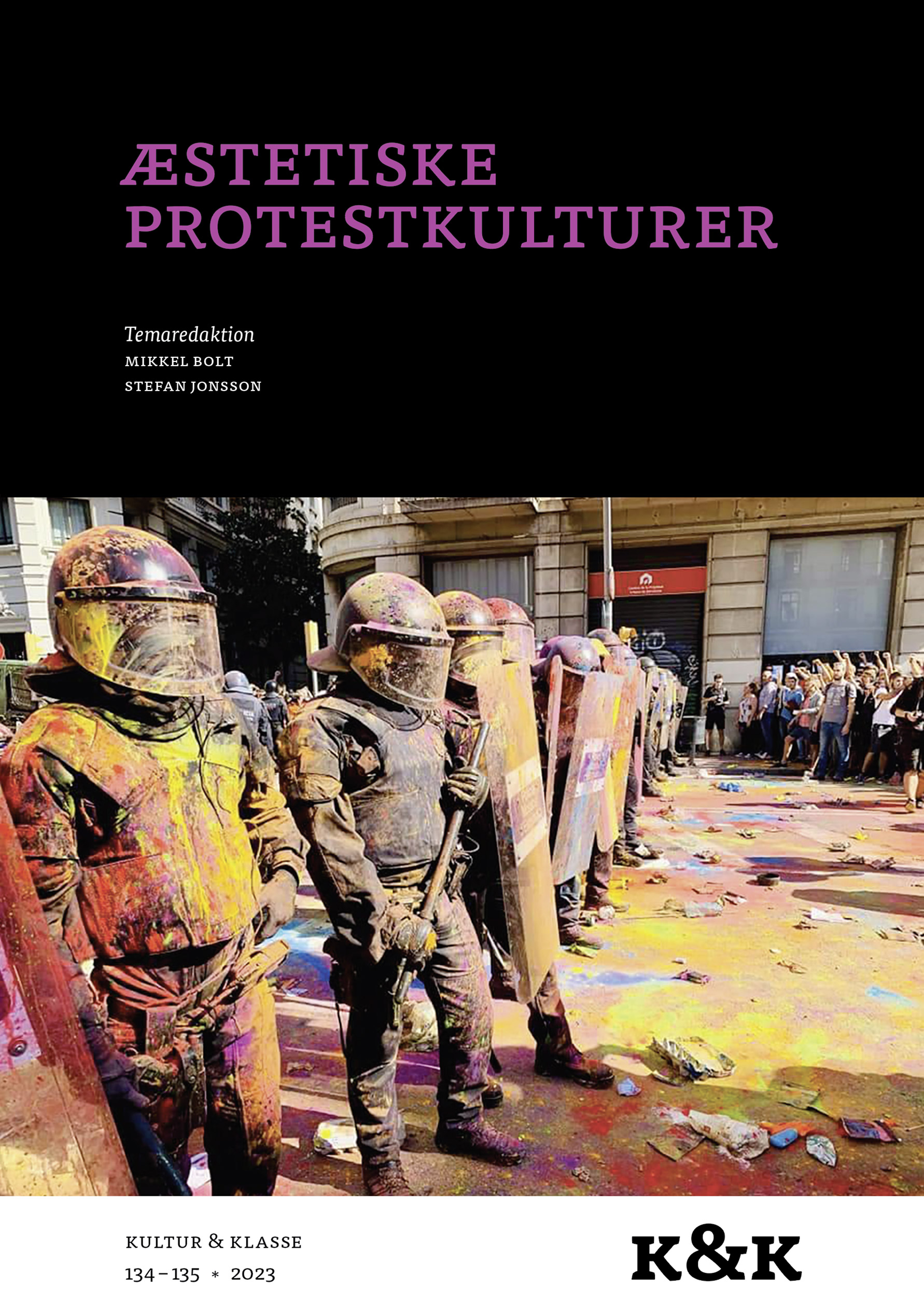Protest, subjekt og udsagn i to nutidige egyptiske eksperimentalfilm
DOI:
https://doi.org/10.7146/kok.v51i134-135.137130Nøgleord:
Eksperimentalfilm, Egypten, Tahrir, The Square, Jehane Noujaim, In the Last Days of the City, Tamer El Said, udsigelse, destitutionResumé
The films The Square (2013) by Jehane Noujaim and In the Last Days of the City (2016) by Tamer El Said both relate to the 2011 uprising in Cairo and its aftermath, albeit in very different ways. The article analyses how the films in each their way mobilise and articulate – rather than represent – political protest and a subject of this protest. The analysis is guided by the hypothesis that parts of critical Egyptian contemporary art, experimental film in particular, have increasingly moved away from the immediate endeavours of the uprising to establish a collective subject and toward a reparation of more unstable, politically seeking subjectivities with a view to destabilise the current authoritarian regime in Egypt. With reference to the political changes in Egypt in the period from 2011 to 2016 the article explores the enunciational conditions for protest in the span between a collectively manifest subject and fragmented, searching subjectivities. In dialog with Elizabeth Kassab’s notion of political humanism, Jacques Rancière’s understanding of political subjectivity, and Giorgio Agamben’s notion of destitution the authors analyse the visual articulation of protest – also where it is not readable as statement and iconography but, on the contrary, precisely insisting in its absence – and try to connect these analyses to reflections on the changing temporality and spatiality of uprising.
Referencer
Aarons, Kieran. ”Destitution and Creation: Agamben’s Messianic Gesture”. Journal of Italian Philosophy, bd. 3, 2020, s. 51-89.
Agamben, Giorgio. Infancy and History: The Destruction of Experience. 1978. Verso, 1993.
Agamben, Giorgio. Brugen af kroppene. 2014. Forlaget THP, 2019.
Arendt, Hannah. The Human Condition. 1958. The University of Chicago Press, 2018.
Baladi, Lara. ”Archiving a Revolution in the Digital Age, Archiving as an Act of Resistance”. Ibraaz, 28. juli 2016, www.ibraaz.org/essays/163/#_ftn10.
Carle, Zoé. ”The voice of the people? Echoes and quotations in the revolutionary slogans in Egypt”. Mediterranean Politics, bd. 26, nr. 1, 2021, s. 55-73. Taylor & Francis Online, doi: 10.1080/13629395.2019.1673417.
Clarke, Killian. ”Authoritarianism, nonviolent resistance, and Egypt’s Kefaya movement”. Social Movements, Nonviolent Resistance, and the State, redigeret af Hank Johnston, Routledge, 2019, s. 211-235, doi: 10.4324/9780429467783-11.
Benjamin, Walter. ”Forsøg på en kritik af volden”. 1921. Kulturindustri: Udvalgte skrifter. Rhodos, 1973, s. 13-41.
Didi-Huberman, Georges. Soulèvements. Gallimard/Jeu de Paume, 2016.
Didi-Huberman, Georges. ”Conflicts of Gestures, Conflicts of Images”. The Nordic Journal of Aesthetics, nr. 55-56, 2018, s. 8-22. Research Gate, doi: 10.7146/nja.v27i55-56. 110720.
El-Nawawy, Mohammed and El-Masry, Mohamed Hamas. ”The Signs of a Strongman: A Semiotic and Discourse Analysis of Abdelfattah Al-Sisi’s Egyptian Presidential Campaign.” International Journal of Communication, bd. 10, 2016, s. 2275-2296.
El Rashidi, Yasmine. ”Cairo Without End.” The New York Review of Books. 27. januar 2017, https://www.nybooks.com/online/2017/01/17/cairo-without-end-in-the-last-days-of-the-city/
Elsadda, Hoda. ”An Archive of Hope: Translating Memories of Revolution”. Translating Dissent: Voices from and with the Egyptian Revolution, redigeret af Mona Baker. Routledge, 2015.
Guillaume, Gustave. Temps et verbe: théorie des aspects, des modes et des temps; suivi de L’Architectonique du temps dans les langues classiques. Éditions Champion, 1965.
Hamilton, Omar Robert. ”Moments of Clarity”. Testimony Between History and Memory, nr. 123, 2016, s. 151-155. Journals Open Edition, doi: 10.4000/temoigner.5419.
Kabesh, Amal Treacher. ”Troubling States of Mind: Sacrifing the Other”. Traces of Violence and Freedom of Thought, redigeret af Lene Auestad og Amal Treacher Kabesh. Palgrave Macmillian, 2017, s. 185-198.
Kassab, Elizabeth. Contemporary Arab Thought. Columbia University Press, 2010.
Kassab, Elizabeth. Enlightenment on the Eve of Revolution: The Egyptian and Syrian Debates. Columbia University Press, 2019. De Gruyter, doi: 10.7312/kass17632.
LeVine, Mark. ”When Art Is the Weapon: Culture and Resistance Confronting Violence in the Post-Uprisings Arab World”. Religions, bd. 6, nr. 4, 2015, s. 1277-1313. MDPI, doi: 10.3390/rel6041277.
Lund, Jacob. Den subjektive rest: Udsigelse og (de)subjektivering i kunst og teori. Aarhus Universitetsforlag, 2008.
Malmvig, Helle. ”Eyes Wide Shut: Power and Creative Visual Counter-Conducts in the Battle for Syria, 2011–2014”. Global Society, bd. 30, nr. 2, 2016, s. 258-278. Taylor & Francis Online, doi: 10.1080/13600826.2016.1150810.
Mossallam, Alia. ”A Permanent Temporariness: Ten Years after the Egyptian Revolution”. Heinrich Böll Stiftung, 20. januar 2021, www.boell.de/en/2021/01/20/permanent-temporariness.
Rancière, Jacques. Det sanseliges deling. 2000. Den frigjorte tilskuer / Det sanseliges deling. Informations Forlag, 2021.
Rancière, Jacques og Davide Panagia. ”Dissenting Words: A Conversation with Jacques Rancière”. Diacritics, bd. 30, nr. 2, 2000, s. 113-126. Project MUSE, doi: 10.1353/dia.2000.0016.
Sanders IV, Lewis. “Signs and Signifiers: Visual Translations of Revolt”. Translating Egypt’s Revolution: The Language of Tahrir, redigeret af Samia Mehrez. The American University in Cairo Press, 2012, s. 103-142. Oxford Academic, doi: 10.5743/cairo/9789774165337.003.0004.
Snowdon, Peter. ”The Revolution Will be Uploaded: Vernacular Video and the Arab Spring”. Culture Unbound, bd. 6, nr. 2, 2014, s. 401-429. Culture Unbound, doi: 10.3384/cu. 2000.1525.146401.
Stiegler, Bernard. De la misère symbolique, 1: L’époque hyperindustrielle. Galilée, 2004.
Westmoreland, Mark. ”Street Scenes: The Politics of Revolutionary Video in Egypt”. Visual Anthropology, bd. 29, nr. 3, 2016, nr. 243-262. Taylor & Francis Online, doi: 10.1080/08949468.2016.1154420.
Downloads
Publiceret
Citation/Eksport
Nummer
Sektion
Licens
Tidsskriftet følger dansk ophavsret.





